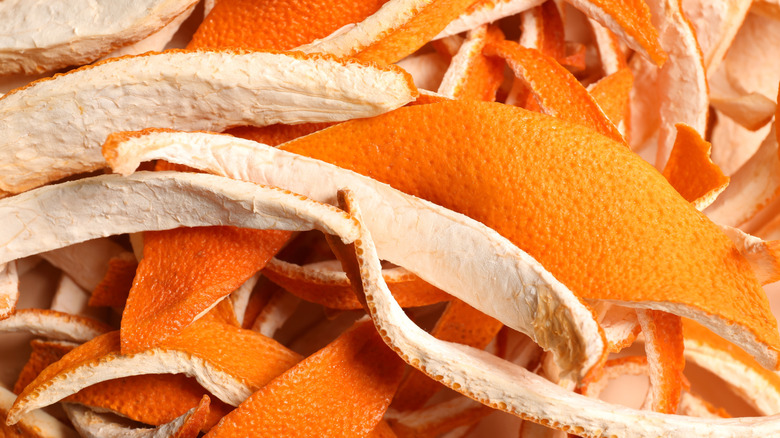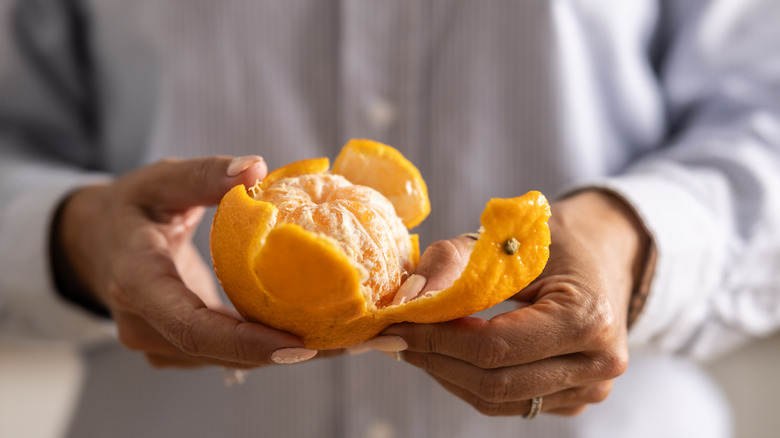The Bizarre Thing That Happens When You Put Orange Peel Juice On A Balloon
If you grew up with an interest in science, you might well have fond memories of your school days spent carrying out fun science experiments designed to spark your young imagination and foster a love for STEM subjects. From balloon-propelled cars to baking soda and vinegar volcanoes, these simple experiments brought what would otherwise have been dull equations and theories to life.
Of course as we grow up and maintain an interest in science, we become fascinated by much more complex ideas, such as quantum mechanics and the mysteries of the cosmos. But every now and then it's fun to appreciate the simplicity of science with a good old practical experiment that demonstrates the wonderful complexity of the world around us. For instance, take the extremely simple example of using orange peel to pop balloons. It seems the skin of this particular citrus can cause the rubber of a balloon to deteriorate completely, proving you don't need something sharp to pop a balloon. Like all of these fun, simple experiments, there is a lot going on under the surface that reveals some fascinating facts about chemical compounds and how they interact.
Orange peels share something in common with balloons
The folks over at Chemical Educational Xchange looked more deeply into how orange peels can be so reliably lethal for balloons, and uncovered the science behind the effect. It turns out a compound in orange peels called limonene is not only responsible for giving the fruit its distinctive smell, but is also responsible for popping balloons when placed in close proximity.
Limonene is a hydrocarbon which is any organic chemical compound that's composed solely of carbon and hydrogen. Hydrocarbons are what are known as non-polar molecules, which means the carbon and hydrogen atoms are very similar in terms of their electronegativity. The electrons in the molecule are evenly distributed, resulting in no significant charge difference across the molecule. Essentially, the hydrogen and carbon atoms share the electrons in the molecule evenly, meaning no part of the molecule has an overwhelmingly positive or negative charge.
In chemistry, there is a principle known as "Like Dissolves Like," which in simple terms means that polar substances will usually dissolve in polar solvents, and non-polar substances in non-polar solvents. You might see where this is going. What kind of a compound makes up balloons? A non-polar one. Rubber is just like limonene in the sense it is also a hydrocarbon, which in turn means it's non-polar. As a result of the "Like Dissolves Like" principle, when limonene oil hits the rubber of a balloon, it dissolves the surface of the balloon, causing it to pop. The Chemical Educational Xchange team even tested this explanation by extracting limonene oil from orange peels and applying it directly to the surface of a balloon, confirming the science behind this fascinating effect — which you can see in action in a video from YouTuber Tommy Technetium.
It's not just oranges that can pop balloons, but not all balloons are the same
Interestingly enough, not all balloons pop in the presence of limonene, which might seem odd considering the solid science behind non-polar compounds reliably breaking down other non-polar compounds. But there's an extra level of resilience added to most balloons, which makes them much tougher to break.
Rubber contains very long isoprene molecules, which in natural rubber can easily separate. But vulcanization can change that property altogether. This process involves treating the rubber with sulfur which results in the long polymer strands strengthening their connection via sulfur atoms, creating something called a cross-link. Essentially, this process makes vulcanized rubber a lot tougher than its natural counterpart, which allows it to become much more resilient when doused with limonene.
According to Chemical Educational Xchange, which took infrared spectra of various balloons, most balloons are actually made with vulcanized rubber. That means that the orange peel trick won't work with your typical birthday balloon. Water balloons, however, are designed to break more easily, and therefore don't use vulcanized rubber, meaning oranges and their limonene molecules will easily break down their surface. Lemons also contain limonene, which means they can also be used to demonstrate this neat trick.


